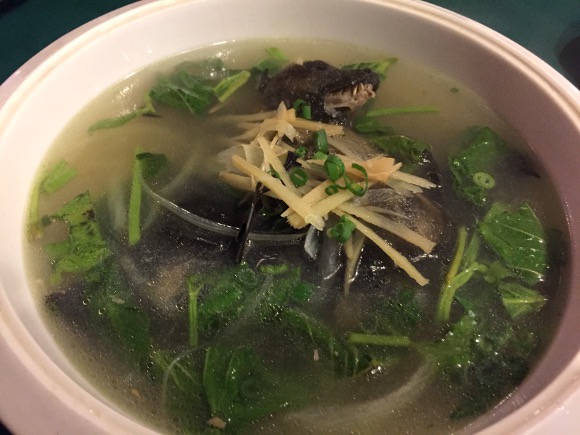
Beauty is in the eye of the beholder, and that goes for meals as well.
Palau is regarded as one of the most naturally beautiful countries in the world with its bounties of pristine oceans, gorgeous marine life and lush landscapes. Our writer PK Sanjun had become deeply enamored with it all during his brief visit.
His tour guide was also quite helpful, teaching PK all about life on the island. For example, not unlike Japan, Palau’s protein historically came almost exclusively from fish, hence it’s become a country with excellent seafood.
▼ Great sashimi isn’t hard to come by in Palau
That can be limiting, however, with not many other options for meat. This is why some in Micronesia had taken to eating bats as an alternate source of protein. Nowadays, Palau gets a lot of its meat imported from the US, so bat isn’t much in demand, but it still exists as a delicacy.
The guide said that fruit bats were eaten there because of their fruit-based diet which resulted in a sweet meat. That didn’t sound so bad, and not being one to pass up a chance at a unique eating experience, PK asked his guide to show him where bat can be eaten.
Our reporter ended up at a restaurant called Mog Mog on the central Island of Koror. It is a well known establishment partly due to its conspicuous sign featuring a huge crab with a pair of chopsticks and knocking back a cold one.
PK ordered a Bat Soup (with Ginger) for US$30 and waited nervously. As he waited, reassuring thoughts passed through his mind such as “How different can bat be from beef or chicken, anyway?” and “It’s probably just a part of the soup stock or minced into little meatballs or something.”
Boy, was he wrong.
PK stifled a scream, as through the murky broth the whole lifeless body of a bat could be seen soaking, with its face defiantly piercing the surface. He wasn’t really sure what to do with this, but luckily his server took the lead and began to remove the bat.
So as not to be rude, PK again had to internalize an instinctive “GYAHHHH!” thinking he saw the bat suddenly move while the server placed it on a separate dish. “Just drink the soup first,” she kindly instructed, and then took away the bat for further preparation.
Ten minutes later, PK’s trauma was beginning to subside when suddenly the second course of his bat soup appeared.
“GYAAHHHH!” thought PK again after seeing that the chef chose to dress the bat up like some kind of demon by sticking chili pepper’s in its eye sockets and and mouth like some devil horns and tongue.
He wondered if the chef actually did this on purpose and whether it was actually possible to decorate food in such a way as to make it less palatable. Still, he had come all this way. It would be foolish not to try it at this point, so PK grabbed a leg and took a bite.
PK described it as tasting like the chiai of a tuna. The term “chiai” refers to the dark red section of a fish that tends to have a bloody smell and texture more like red meat than fish. It is rarely used in sushi or sashimi and usually relegated to cat food, although it does have its fans.
In other words, it didn’t taste bad at all, but there wasn’t enough there to redeem it from the initial impact of its presentation. PK found himself unable to get past the first bite and just gave the rest away to another group of Japanese tourists at the next table.
Perhaps unsurprisingly, bat soup turned out not to be a hidden gourmet gem. But PK could relate to its existence, because even in the more inland areas of Japan some people have taken to some unconventional food sources like giant hornets. Likely in the same way, bat was just an acquired taste.
So, if you want a truly unique dining experience in Palau, you now know where to get it. Otherwise, you’d probably be better off sticking with the sushi.
Photos ©SoraNews24
[ Read in Japanese ]

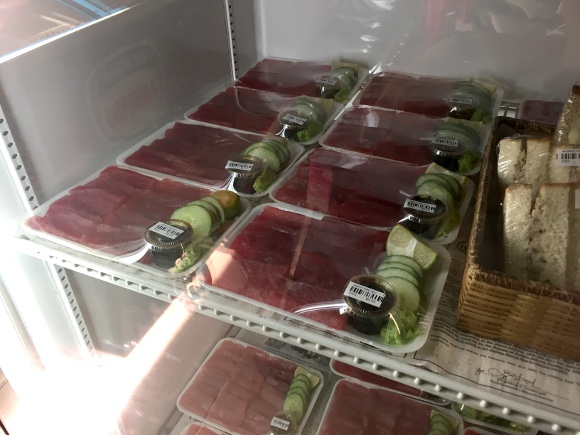
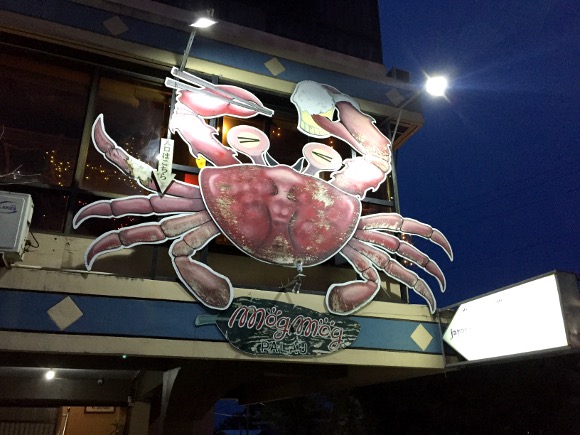
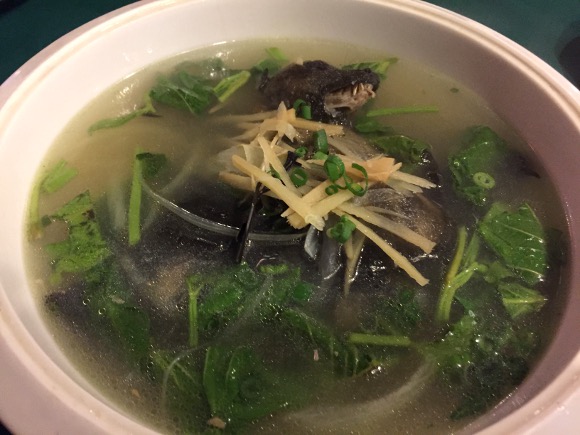
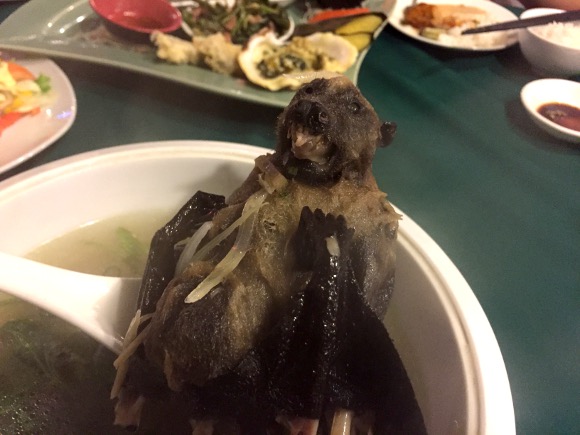
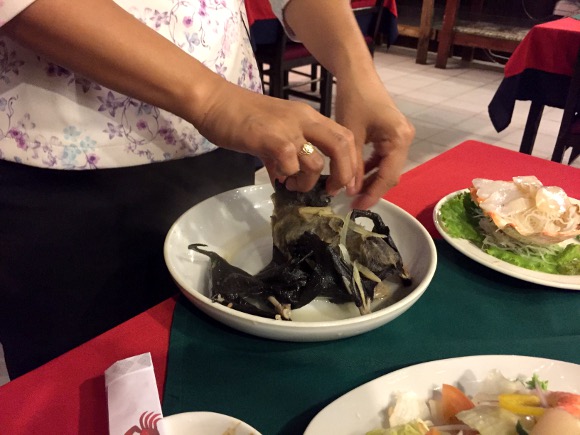
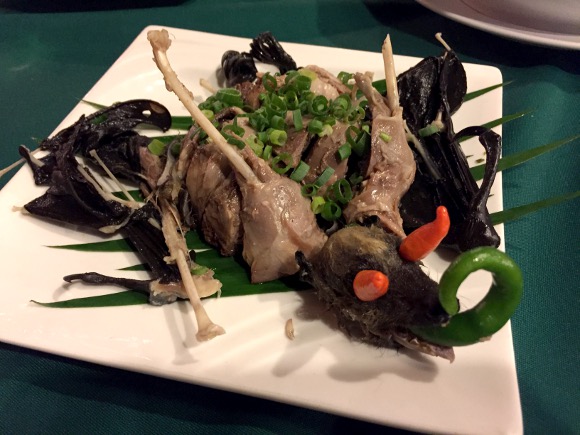
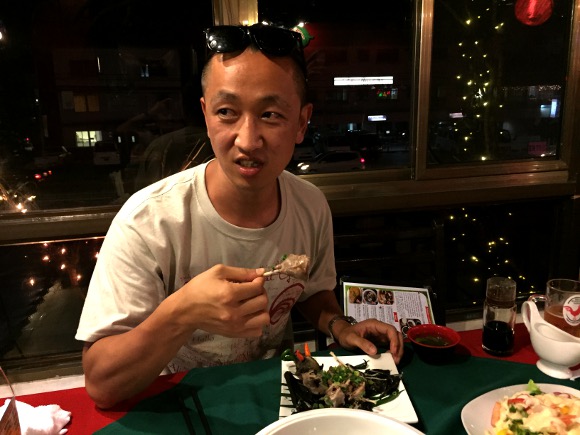
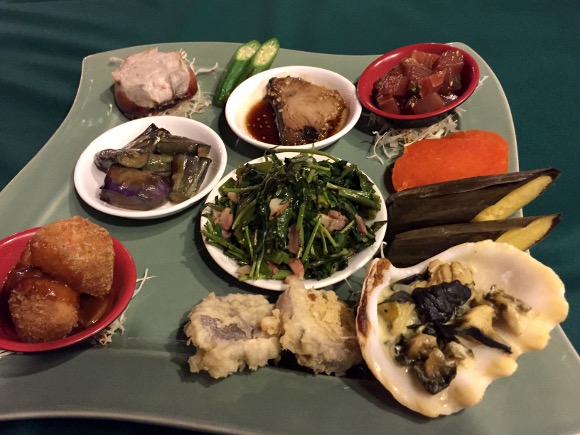
 Fishin’ for crawdads in Tokyo: A tale of friendship
Fishin’ for crawdads in Tokyo: A tale of friendship Our reporters search for the spirit of Halloween in Shibuya and make some new friends
Our reporters search for the spirit of Halloween in Shibuya and make some new friends We brave fastballs from the world’s fastest (and most terrifying) pitching machine
We brave fastballs from the world’s fastest (and most terrifying) pitching machine Large bat species discovered to be breeding in Japan for the first time
Large bat species discovered to be breeding in Japan for the first time Young boy’s first baseball hit smacks a very golden prize【Video】
Young boy’s first baseball hit smacks a very golden prize【Video】 How to order snacks on a Shinkansen bullet train in Japan
How to order snacks on a Shinkansen bullet train in Japan Japan’s new difficult-to-drink-from beer glass protects your liver, but it’s a brutal experience
Japan’s new difficult-to-drink-from beer glass protects your liver, but it’s a brutal experience Burger King Japan suddenly adds Dr. Pepper and Dr. Pepper floats to its menu nationwide
Burger King Japan suddenly adds Dr. Pepper and Dr. Pepper floats to its menu nationwide Demon Slayer: Kimetsu no Yaiba gets new roller coaster attractions and food at Universal Studios Japan
Demon Slayer: Kimetsu no Yaiba gets new roller coaster attractions and food at Universal Studios Japan Hello, cosmetics! Clinique teams up with Hello Kitty this summer for first-time collaboration
Hello, cosmetics! Clinique teams up with Hello Kitty this summer for first-time collaboration Kyoto Tower mascot termination reveals dark side behind cute Japanese characters
Kyoto Tower mascot termination reveals dark side behind cute Japanese characters Nintendo history you can feel – Super NES, N64, and GameCube controllers become capsule toys
Nintendo history you can feel – Super NES, N64, and GameCube controllers become capsule toys This Nara workshop has been making deer crackers for more than 100 years and offers tours【Photos】
This Nara workshop has been making deer crackers for more than 100 years and offers tours【Photos】 High-fashion Totoro cuddle purse is like an elegant stroll in the forest【Photos】
High-fashion Totoro cuddle purse is like an elegant stroll in the forest【Photos】 Legendary Melon Bread by Tokyo Banana returns after 20-year absence【Taste Test】
Legendary Melon Bread by Tokyo Banana returns after 20-year absence【Taste Test】 “The most Delicious Cup Noodle in history” – Japan’s French Cup Noodle wins our heart【Taste test】
“The most Delicious Cup Noodle in history” – Japan’s French Cup Noodle wins our heart【Taste test】 Starbucks releases a cute Frappuccino and Unicorn Cake…but not in Japan
Starbucks releases a cute Frappuccino and Unicorn Cake…but not in Japan McDonald’s Japan’s Soft Twist Tower: A phantom ice cream only sold at select branches
McDonald’s Japan’s Soft Twist Tower: A phantom ice cream only sold at select branches Yabai Ramen: What makes this Japanese ramen so dangerous?
Yabai Ramen: What makes this Japanese ramen so dangerous? Finally! Nintendo Japan expands Switch 8-bit controller sales to everybody, Online member or not
Finally! Nintendo Japan expands Switch 8-bit controller sales to everybody, Online member or not Japanese government wants to build luxury resorts in all national parks for foreign tourists
Japanese government wants to build luxury resorts in all national parks for foreign tourists To combat declining birth rate, Japan to begin offering “Breeding Visas” to foreigners
To combat declining birth rate, Japan to begin offering “Breeding Visas” to foreigners 10 things you should buy at 7-Eleven in Japan
10 things you should buy at 7-Eleven in Japan Studio Ghibli releases anime heroine cosplay dresses that are super comfy to wear
Studio Ghibli releases anime heroine cosplay dresses that are super comfy to wear Woman charged for driving suitcase without a license in Osaka
Woman charged for driving suitcase without a license in Osaka Studio Ghibli unveils My Neighbour Totoro miniature house model
Studio Ghibli unveils My Neighbour Totoro miniature house model Kyoto experiencing problems with foreign tourists not paying for bus fares, but not on purpose
Kyoto experiencing problems with foreign tourists not paying for bus fares, but not on purpose Fighting mild hunger with a Japanese soda that turns into jelly in the stomach【Taste test】
Fighting mild hunger with a Japanese soda that turns into jelly in the stomach【Taste test】 Studio Ghibli’s Howl’s Moving Castle tapestry unveiled in Japan for first time
Studio Ghibli’s Howl’s Moving Castle tapestry unveiled in Japan for first time McDonald’s new Happy Meals offer up cute and practical Sanrio lifestyle goods
McDonald’s new Happy Meals offer up cute and practical Sanrio lifestyle goods Sales of Japan’s most convenient train ticket/shopping payment cards suspended indefinitely
Sales of Japan’s most convenient train ticket/shopping payment cards suspended indefinitely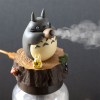 Sold-out Studio Ghibli desktop humidifiers are back so Totoro can help you through the dry season
Sold-out Studio Ghibli desktop humidifiers are back so Totoro can help you through the dry season Japanese government to make first change to romanization spelling rules since the 1950s
Japanese government to make first change to romanization spelling rules since the 1950s Foreigner’s request for help in Tokyo makes us sad for the state of society
Foreigner’s request for help in Tokyo makes us sad for the state of society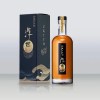 Ghibli founders Toshio Suzuki and Hayao Miyazaki contribute to Japanese whisky Totoro label design
Ghibli founders Toshio Suzuki and Hayao Miyazaki contribute to Japanese whisky Totoro label design Doraemon found buried at sea as scene from 1993 anime becomes real life【Photos】
Doraemon found buried at sea as scene from 1993 anime becomes real life【Photos】 Tokyo’s most famous Starbucks is closed
Tokyo’s most famous Starbucks is closed Princesses, fruits, and blacksmiths: Study reveals the 30 most unusual family names in Japan
Princesses, fruits, and blacksmiths: Study reveals the 30 most unusual family names in Japan Cup Noodles Breakfast: a curse against instant ramen or the best thing since sliced bread?
Cup Noodles Breakfast: a curse against instant ramen or the best thing since sliced bread? Four things you should eat at Japanese chain Ringer Hut, according to staff who work there
Four things you should eat at Japanese chain Ringer Hut, according to staff who work there The Bat Cave apartment: a unique place to stay in Shibuya, Tokyo
The Bat Cave apartment: a unique place to stay in Shibuya, Tokyo You’ve never seen Tokyo’s nightscape quite like this【Photos】
You’ve never seen Tokyo’s nightscape quite like this【Photos】 This London ramen restaurant’s super-strange ramen shocks our Japanese taste-tester
This London ramen restaurant’s super-strange ramen shocks our Japanese taste-tester Friend’s reaction to high school boy’s penchant for crossdressing is both unexpected and cute
Friend’s reaction to high school boy’s penchant for crossdressing is both unexpected and cute Christmas photo hack: Create magical images with oil from your body
Christmas photo hack: Create magical images with oil from your body Osaka man reserved and cancelled 1,873 seats at two baseball games to get more space for self
Osaka man reserved and cancelled 1,873 seats at two baseball games to get more space for self Sadako vs Kayako take to the field as they open baseball game in Hokkaido
Sadako vs Kayako take to the field as they open baseball game in Hokkaido Fukuoka pro-baseball team sells beer cups made from bats used by players
Fukuoka pro-baseball team sells beer cups made from bats used by players “Where are ya!? I’ll fight ya!!!” Cat battles air for over a minute in adorable video
“Where are ya!? I’ll fight ya!!!” Cat battles air for over a minute in adorable video Ichiro turns down award from Japan’s Prime Minister for the third time
Ichiro turns down award from Japan’s Prime Minister for the third time Japanese baseball player’s sweet story of how he wooed his fiancé moves Twitter, inspires puns
Japanese baseball player’s sweet story of how he wooed his fiancé moves Twitter, inspires puns We go to a 7-Eleven in Aomori and find a surprising “one per family” item on the shelf
We go to a 7-Eleven in Aomori and find a surprising “one per family” item on the shelf Dozens of Peppers and Spots join forces for a creepy robot 7th inning stretch spectacular
Dozens of Peppers and Spots join forces for a creepy robot 7th inning stretch spectacular
Leave a Reply